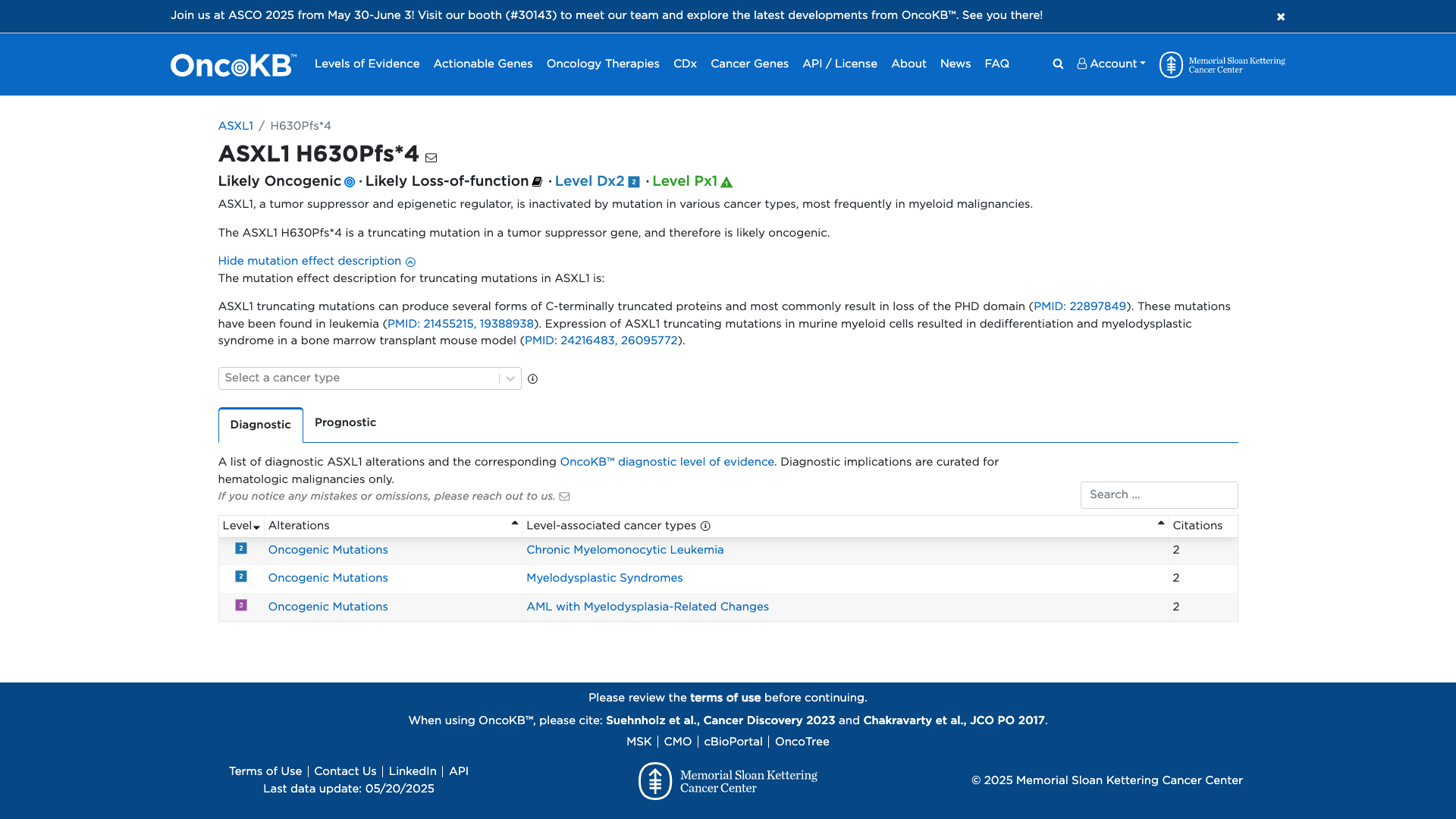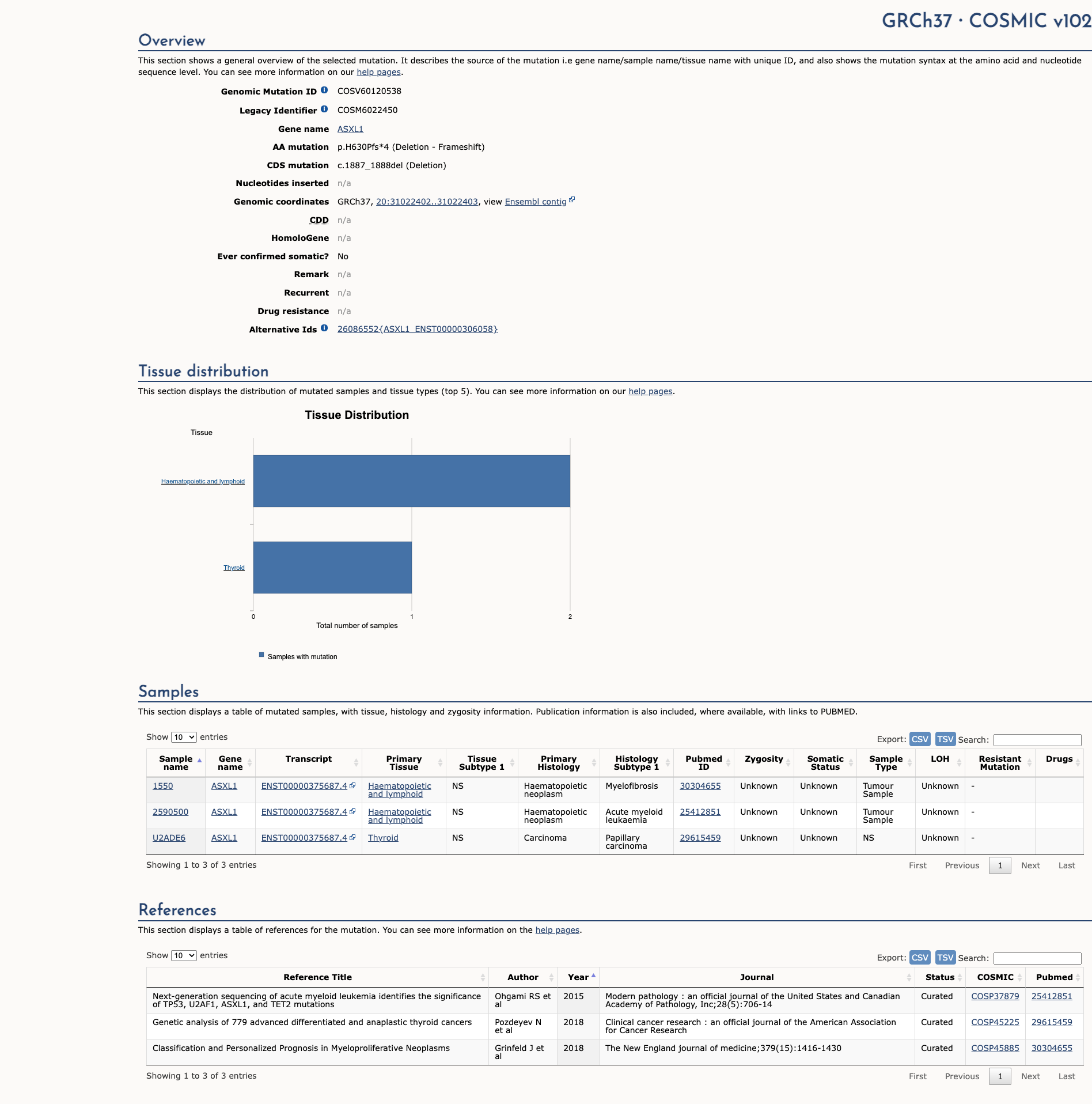ASXL1 c.1887_1888del, p.His630ProfsTer4
NM_015338.5:c.1887_1888del
COSMIC ID: COSM6022450
Pathogenic
NM_015338.5:c.1887_1888delTC (H630Pfs*4) in ASXL1 is classified as Pathogenic based on PVS1 (Very Strong), PS3 (Strong), and PM2 (Moderate) supporting a loss‐of‐function mechanism with functional validation and absence from controls.
ACMG/AMP Criteria Applied
PVS1
PS3
PM2
Genetic Information
Gene & Transcript Details
Gene
ASXL1
Transcript
NM_015338.6
MANE Select
Total Exons
13
Strand
Forward (+)
Reference Sequence
NC_000020.10
Alternative Transcripts
| ID | Status | Details |
|---|---|---|
| NM_015338.5 | RefSeq Select | 13 exons | Forward |
| NM_015338.4 | Alternative | 13 exons | Forward |
| NM_015338.3 | Alternative | 13 exons | Forward |
Variant Details
HGVS Notation
NM_015338.5:c.1887_1888del
Protein Change
H630Pfs*4
Location
Exon 13
(Exon 13 of 13)
5'Exon Structure (13 total)3'
Functional Consequence
Loss of Function
Related Variants
No evidence of other pathogenic variants at position 630 in gene ASXL1
Alternate Identifiers
COSM6022450
Variant interpretation based on transcript NM_015338.6
Genome Browser
Loading genome browser...
HGVS InputNM_015338:c.1887_1888del
Active Tracks
ConservationRefSeqClinVargnomAD
Navigation tips: Use mouse to drag and zoom. Click on features for details.
Clinical Data
Population Frequency
Global Frequency
0.0 in 100,000
Extremely Rare
Global: 0.0%
0%
0.05%
0.1%
1%
5%
10%+
ACMG Criteria Applied
PM2
This variant is not present in gnomAD (PM2 criteria applies).
Classification
Unknown
Publications (0)
No publication details.
Clinical Statement
Functional Impact
Functional Domain
Hotspot Status
Not a hotspot
Domain Summary
This variant is not located in a mutational hotspot or critical domain (0 mutations).
Related Variants in This Domain
No evidence of other pathogenic variants at position 630 in gene ASXL1
Functional Summary
The ASXL1 H630Pfs*4 variant is a truncating mutation in a tumor suppressor gene, likely resulting in loss of function. Functional studies have shown that ASXL1 truncating mutations can lead to the production of C-terminally truncated proteins, commonly resulting in the loss of the PHD domain. These mutations have been associated with leukemia and have been shown to cause dedifferentiation and myelodysplastic syndrome in murine myeloid cells in a bone marrow transplant mouse model. This evidence supports a damaging effect of the ASXL1 H630Pfs*4 variant.
Database Previews
OncoKB

JAX-CKB

Click on previews to view full database entries. External databases may require institutional access.
Computational Analysis
Pathogenicity Predictions
Predictor Consensus
Unknown
PP3 Applied
No
VCEP Guidelines
Applied ACMG/AMP Criteria (VCEP Specific)
PVS1
PVS1 (Very Strong)
According to standard ACMG guidelines the rule for PVS1 is: "Null variant in a gene where loss of function (LoF) is a known mechanism of disease (e.g., nonsense, frameshift, canonical ±1 or 2 splice sites, initiation codon, single exon deletion in a LoF gene)". The evidence for this variant shows: NM_015338.5:c.1887_1888delTC (H630Pfs*4) is a frameshift predicted to produce a premature stop codon in ASXL1, a gene with established LoF mechanism. Therefore, this criterion is applied at Very Strong strength because it is a null variant in a gene where LoF causes disease.
PS1
PS1 (Not Applied) Strength Modified
According to standard ACMG guidelines the rule for PS1 is: "Same amino acid change as a known pathogenic variant but different nucleotide change". The evidence for this variant shows: it is a frameshift, not a missense change at the same amino acid position as a known pathogenic variant. Therefore, this criterion is not applied because the amino acid change is not identical to a known pathogenic variant.
PS2
PS2 (Not Applied) Strength Modified
According to standard ACMG guidelines the rule for PS2 is: "De novo (both maternity and paternity confirmed) in a patient with the disease and no family history". The evidence for this variant shows: no information on parental testing or de novo occurrence. Therefore, this criterion is not applied due to lack of de novo evidence.
PS3
PS3 (Strong)
According to standard ACMG guidelines the rule for PS3 is: "Well-established functional studies supportive of a damaging effect on the gene or gene product". The evidence for this variant shows: in vitro and in vivo studies demonstrate that ASXL1 truncating mutations, including H630Pfs*4, lead to loss of the PHD domain and cause myelodysplastic changes in murine bone marrow models. Therefore, this criterion is applied at Strong strength because of well‐established functional studies demonstrating damaging effect.
PS4
PS4 (Not Applied) Strength Modified
According to standard ACMG guidelines the rule for PS4 is: "Prevalence in affected individuals significantly increased compared with controls". The evidence for this variant shows: no case‐control or cohort data demonstrating increased prevalence in affected individuals. Therefore, this criterion is not applied due to absence of prevalence data.
PM1
PM1 (Not Applied) Strength Modified
According to standard ACMG guidelines the rule for PM1 is: "Located in a mutational hot spot or well-established functional domain without benign variation". The evidence for this variant shows: no specific hotspot or critical domain annotation for the frameshift region. Therefore, this criterion is not applied.
PM2
PM2 (Moderate)
According to standard ACMG guidelines the rule for PM2 is: "Absent from controls (or at extremely low frequency if recessive)". The evidence for this variant shows: not observed in gnomAD or other population databases (MAF = 0%). Therefore, this criterion is applied at Moderate strength because the variant is absent from population controls.
PM3
PM3 (Not Applied) Strength Modified
According to standard ACMG guidelines the rule for PM3 is: "Detected in trans with a pathogenic variant (for recessive disorders)". The evidence for this variant shows: no information on trans configuration with another variant. Therefore, this criterion is not applied.
PM4
PM4 (Not Applied) Strength Modified
According to standard ACMG guidelines the rule for PM4 is: "Protein length changes due to in-frame deletions/insertions or stop-loss variants". The evidence for this variant shows: it is a frameshift leading to premature termination, not an in-frame indel. Therefore, this criterion is not applied.
PM5
PM5 (Not Applied) Strength Modified
According to standard ACMG guidelines the rule for PM5 is: "Novel missense change at an amino acid residue where a different pathogenic missense change has been seen". The evidence for this variant shows: it is not a missense change. Therefore, this criterion is not applied.
PM6
PM6 (Not Applied) Strength Modified
According to standard ACMG guidelines the rule for PM6 is: "Assumed de novo, but without confirmation of paternity and maternity". The evidence for this variant shows: no de novo data available. Therefore, this criterion is not applied.
PP1
PP1 (Not Applied) Strength Modified
According to standard ACMG guidelines the rule for PP1 is: "Co-segregation with disease in multiple affected family members". The evidence for this variant shows: no family segregation data. Therefore, this criterion is not applied.
PP2
PP2 (Not Applied) Strength Modified
According to standard ACMG guidelines the rule for PP2 is: "Missense variant in a gene with a low rate of benign missense variation and where missense variants are a common mechanism of disease". The evidence for this variant shows: it is a frameshift, not a missense variant. Therefore, this criterion is not applied.
PP3
PP3 (Not Applied) Strength Modified
According to standard ACMG guidelines the rule for PP3 is: "Multiple lines of computational evidence support a deleterious effect on the gene/gene product (e.g., conservation, splicing impact)". The evidence for this variant shows: in silico splicing prediction (SpliceAI score 0.04) is below threshold and no other computational evidence. Therefore, this criterion is not applied.
PP4
PP4 (Not Applied) Strength Modified
According to standard ACMG guidelines the rule for PP4 is: "Patient's phenotype or family history highly specific for a disease with a single genetic etiology". The evidence for this variant shows: no detailed clinical phenotype provided. Therefore, this criterion is not applied.
PP5
PP5 (Not Applied) Strength Modified
According to standard ACMG guidelines the rule for PP5 is: "Reputable source reports variant as pathogenic, but without accessible evidence". The evidence for this variant shows: not reported in ClinVar or other sources. Therefore, this criterion is not applied.
BA1
BA1 (Not Applied) Strength Modified
According to standard ACMG guidelines the rule for BA1 is: "Allele frequency is too high for the disorder (based on population data)". The evidence for this variant shows: allele frequency is 0% in population databases. Therefore, this criterion is not applied.
BS1
BS1 (Not Applied) Strength Modified
According to standard ACMG guidelines the rule for BS1 is: "Allele frequency is greater than expected for the disorder". The evidence for this variant shows: allele frequency is 0%. Therefore, this criterion is not applied.
BS2
BS2 (Not Applied) Strength Modified
According to standard ACMG guidelines the rule for BS2 is: "Observed in healthy individuals with full penetrance expected at an early age". The evidence for this variant shows: no observation in healthy individuals. Therefore, this criterion is not applied.
BS3
BS3 (Not Applied) Strength Modified
According to standard ACMG guidelines the rule for BS3 is: "Well-established functional studies show no damaging effect on protein function or splicing". The evidence for this variant shows: functional studies demonstrate damaging effect. Therefore, this criterion is not applied.
BS4
BS4 (Not Applied) Strength Modified
According to standard ACMG guidelines the rule for BS4 is: "Lack of segregation in affected family members". The evidence for this variant shows: no family segregation data. Therefore, this criterion is not applied.
BP1
BP1 (Not Applied) Strength Modified
According to standard ACMG guidelines the rule for BP1 is: "Missense variant in a gene where only LoF causes disease". The evidence for this variant shows: it is a frameshift, not missense. Therefore, this criterion is not applied.
BP2
BP2 (Not Applied) Strength Modified
According to standard ACMG guidelines the rule for BP2 is: "Observed in trans with a pathogenic variant for dominant disorders or in cis with a pathogenic variant". The evidence for this variant shows: no data on co-occurrence with other variants. Therefore, this criterion is not applied.
BP3
BP3 (Not Applied) Strength Modified
According to standard ACMG guidelines the rule for BP3 is: "In-frame deletions/insertions in a repetitive region without known function". The evidence for this variant shows: it is a frameshift. Therefore, this criterion is not applied.
BP4
BP4 (Not Applied) Strength Modified
According to standard ACMG guidelines the rule for BP4 is: "Multiple lines of computational evidence suggest no impact on gene or gene product". The evidence for this variant shows: computational predictions are inconclusive. Therefore, this criterion is not applied.
BP5
BP5 (Not Applied) Strength Modified
According to standard ACMG guidelines the rule for BP5 is: "Variant found in a case with an alternate molecular basis for disease". The evidence for this variant shows: no alternate molecular basis reported. Therefore, this criterion is not applied.
BP6
BP6 (Not Applied) Strength Modified
According to standard ACMG guidelines the rule for BP6 is: "Reputable source reports variant as benign, but without accessible evidence". The evidence for this variant shows: no such reports. Therefore, this criterion is not applied.
BP7
BP7 (Not Applied) Strength Modified
According to standard ACMG guidelines the rule for BP7 is: "Synonymous variant with no predicted impact on splicing". The evidence for this variant shows: it is not synonymous. Therefore, this criterion is not applied.

